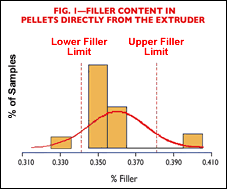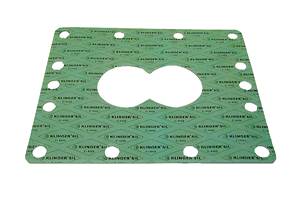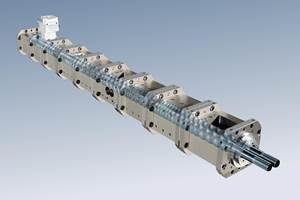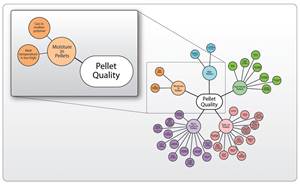Cure Feeder Problems in Twin-Screw Compounding
The dilemma for compounders with starve-fed twin-screw extruders is how to keep the formulation constant within the extruder barrel.
The dilemma for compounders with starve-fed twin-screw extruders is how to keep the formulation constant within the extruder barrel. Compounders rely on feeders to meter polymers, fillers, and additives into the extruder to achieve specific properties in finished blends.
Say that a compound specification calls for 36.1% filler with a tolerance of ±2.0%, but ash analysis of pellet samples from the extruder range from 34.5% to 40.5% (see Fig. 1 below). Average filler content is within the target specification, but the distribution is too broad.
If pellets are post-blended, this averages out variations in the material delivered from the feeder and will meet the ash specification (Fig. 2 below). While post-blending may solve this problem, it’s not an economical approach to compounding. Such feeding problems may appear randomly, periodically, or constantly—and each level of frequency indicates a different problem that requires a different solution.
Random feeder problems
Product may randomly fail to meet specifications for ash analysis and/or mechanical properties when the feed rate from one or more feeders swings higher or lower, resulting in more or less material entering the extruder barrel. Imagine, for example, that a polymer feeder momentarily feeds above setpoint at the same time that a filler feeder is feeding below setpoint. These two materials fall together into the twin-screw extruder and are conveyed downstream as a “batch” that is below the target filler loading. Now imagine that after some period of time, these same two feeders swing to the opposite extremes, resulting in a “batch” falling into the extruder with a filler loading above target.
The frequency at which the feeders vary, the amplitude of the variation, and the residence time in the extruder will determine the severity of this problem. If the intervals at which feeders are varying are longer than the residence time for material in the extruder, the batch that is below the target filler content has little chance to mix with the batch that is above target. The “low-filler” batch will be in the pelletizer when the “high-filler” batch enters the extruder. The screw design for twin-screw compounders can be modified to increase backmixing somewhat, but there is no screw design that will cure this problem altogether.
This problem usually occurs when either belt feeders or screw feeders are run well below their design capacity. The solution is that the frequency of the feeder variation must be increased to fall within the residence time of material in the extruder. The more frequent the variation, the better.
With screw feeders, when the screw diameter and/or pitch is too large for the feed rate, the screw runs very slowly and produces low-frequency variations. This problem usually produces large feeder errors since the feeder controller is also trying to control the speed of the screw at the low end of its operating range. The screw diameter and/or pitch must be selected so that the feeder screw runs as fast as possible. Consult the manufacturer of the feeder to identify alternate screw types. Belt feeders that are too wide will also run slowly. Again, slow belt speed makes the problem worse because the controller has difficulty in this range. This is an easy fix. Adjust the discharge slide gates so that the feed material occupies only a small area of the belt. This will require the belt to run much faster.
Repeatability is the term used by feeder manufacturers to describe the amplitude of feeder variation. Gravimetric feeders are capable of maintaining ±0.5% repeatability at two standard deviations (2 sigma). This applies to polymers fed in pellet form. Typically, however, most reinforcing and non-reinforcing fillers are powders and flow poorly, so their repeatability values are worse.
Such fillers are usually metered by a primary weigh feeder into a side-feeder of a twin-screw extruder. If the side-feeder is also run in a starve-fed mode, as suppliers usually recommend, feed-rate variations from the primary weigh feeder are transferred directly to the compounding extruder. If the screw speed of the side-feeder is reduced to the point where the screws are flooded, then only the speed of the side-feeder screws determines the feed rate into the extruder. So the side-feeder screws should run at a speed that keeps a constant level of material covering the screws—i.e., when they are flooded.
Note that repeatability is also a function of the sampling interval. Most feeder manufacturers state feeder repeatability for one-minute sampling, which is okay since mean residence time in a conventional twin-screw compounding extruder is in the range of 30 to 60 sec. But high-speed, high-torque compounders with extruders running at screw speeds above 1200 rpm can push mean residence time below 10 sec. In these cases, feeder repeatability must be checked at intervals shorter than a minute. The residence time in high-speed compounding extruders makes them extremely sensitive to feeder variations and prone to resulting quality problems.
Periodic feeder problems
If product periodically fails to meet specifications for ash analysis and/or mechanical properties, the culprit is probably the gravimetric feeder’s refill cycle. Loss-in-weight feeders must be refilled during continuous operation, but they can’t run in gravimetric mode while refilling. As a result, actual feed rate varies from setpoint during and just after refill. Feeder makers have improved their controls to minimize this variation, but some is inevitable.
Actual feed rate during and immediately after refill is usually above setpoint, though the system eventually stabilizes. Common symptoms are momentary surges in filler loading accompanied by surges in extruder torque and sudden blockage of extruder screens.
It is usually the poor flow characteristics of particulate fillers that create this problem. If these fillers are introduced into a side-feeder, reducing the speed of the side feeder just to the point of flooding will eliminate the problem. Another cause of feeder surges is long refill intervals. If you refill the feeder more frequently with less material, it takes less time, so the feeder spends more time in gravimetric control.
Constant feeder problems
If product consistently fails to meet specifications for ash analysis and/or mechanical properties, the culprit is probably calibration of the feeder weighing system. The ability of gravimetric feeders to introduce a specified amount of material depends on calibration of a scale or load-cell weighing system. If the weighing system is out of calibration, the feeder indicates it is feeding the specified amount, but it may not be.
The solution is routine feeder-scale calibration, preferably using NIST-traceable weights. A span value can be entered to adjust the scale reading to match the reference weight. Be sure to use reference weights with at least the same resolution as the feeder display.
Leaking refill systems can also cause gravimetric feeders to feed the wrong amount of material. If the refill system is leaking material into the feeder during continuous operation, the loss-in-weight feeder will compensate by feeding more material. The feeder controller will indicate that everything is okay, since it is feeding to setpoint.
The easiest way to identify this problem is to decouple the refill valve from the feeder and make a visual observation. An alternate method is to force the feeder to be refilled with the feeder stopped and look for an increase in weight on the load cells after the refill valve has closed. The weight on the load cell should not change with the feeder stopped. If the refill system leaks, fix it!
Related Content
10 Ways to Improve Twin-Screw Compounding Performance
There are many techniques known to operators and plant engineers for increasing the performance of a twin-screw compounding extruder.
Read MoreConfiguring the Twin Screw Extruder: Part 4
For many compounding operations, material is fed to the extruder at the feed throat. This is the case when feeding a single polymer or a blend of polymers mixed with solid additives. Some ingredients, however, present a challenge in feeding. Here’s how to solve to them.
Read MoreHow to Configure Your Twin-Screw Barrel Layout
In twin-screw compounding, most engineers recognize the benefits of being able to configure screw elements. Here’s what you need to know about sequencing barrel sections.
Read MoreThe Path to Pellet Perfection
In underwater pelletizing, numerous variables in the equipment, process and material affect pellet shape, consistency and quality factors such as fines. Defining the “perfect” pellet depends on the conditions of end use, and achieving that ideal requires understanding of the causes of imperfections.
Read MoreRead Next
How Polymer Melts in Single-Screw Extruders
Understanding how polymer melts in a single-screw extruder could help you optimize your screw design to eliminate defect-causing solid polymer fragments.
Read MoreUnderstanding Melting in Single-Screw Extruders
You can better visualize the melting process by “flipping” the observation point so that the barrel appears to be turning clockwise around a stationary screw.
Read More (2).jpg;maxWidth=970;quality=90)







 (2).jpg;maxWidth=300;quality=90)






 (1).jpg;maxWidth=970;quality=90)